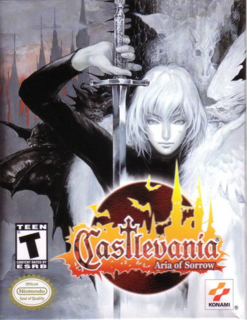What every handheld AND Castlevania game should be...
-Action platform game with RPG elements seamlessly integrated
-Difficulty guides you to areas where you belong
-Three ending possibilities
-Tons of weapons, accessories, and armor combinations
-Large environment with multiple classic areas in castle
-Great music
Cons:
-Small sprites
-Easy bosses
-Three endings… you have to find the "good" one
Castlevania: Aria of Sorrow (CV: AoS) takes the Castlevania series in a fresh, new direction on the GameBoy Advance. Tales of an American exchange student in a Japanese setting start off the scene as Soma Cruz is walking Mina (his love interest) to a shrine in order to observe and watch a century occurring solar eclipse (hence the name derivative). Once the eclipse is full, a floating island appears with a dreadful castle perched on the island. Soma and Mina are sucked through a portal and transported near the floating castle's entrance, with Mina being hurt and unconscious. Soma soon meets a number of individuals and learns the story of the castle and Dracula. From there, Soma sets out to find some answers and save Mina from imminent doom.
In a franchise where the story usually takes a backseat, CV: AoS delivers a superior and captivating story that most games of today cannot deliver even with great CG and cut-scenes. What Soma experiences during his journey and learns as he works his way through Dracula's castle is by far the finest story crafted for any Castlevania game this reviewer has ever played. The ending leaves the player in awe and bewildered. The dénouement helps tie together loose ends created in the other games and gives the game a feeling of belonging in the franchise, a feeling that was absent through the first quarter of the game.
Gameplay is very typical of Castlevania series, if you have played one – you have played them all. Jump, attack, and sub-weapons dominate the overall basic commands and execution of the character's movements. However, there have been a few welcome additions that really differentiate AoS from the previous games. This makes CV:AoS play similar to an Action RPG more-so than a standard platformer. The ability to level and item system features have been implemented in many of the CV games since Symphony of the Night, but few (if any) do it as well as AoS.
Soma can learn skills from the various enemies slain throughout the game. This can be anything from a quick back-step/dodge, throwing axes, transforming into a demon, turning into a bat for flying, or even a sliding maneuver that doubles as an attack. There are a variety of souls Soma can claim, accomplished through killing various enemies and absorbing their souls. Once the player has killed a certain number of enemies (or your luck attribute is high enough), their soul will be added to your list of collected souls.
At any given time, Soma can have three souls equipped: a yellow (guardian/summon souls), a blue (enchant/skill souls), and a red soul (ability/sub-weapon souls). Each soul gives Soma different powers and abilities, requiring the use of a magic meter. The magic meter is recovered by time and the collection of hearts, which varies from the previous games' heart system. In order to get the best ending, the correct combination of souls must be equipped during the final boss fight.
Despite all of the changes made to the overall gameplay and engine, the sound is typical of the Castlevania series. The sound effects are identical to all of the 2D games, featuring the classic slash, items obtained chimes, and the crashing sound of enemy deaths. The score is a mix of the classic themes and remixes, with a few new additions to the soundtrack. Regardless of the game played in the series, the player's ears will always experience a utopia of icon composers' music when playing these games.
While the game shows great polish and promise, it is not without faults and blemishes. Some of the areas where CV: AoS falls short are the detail of the sprites and character models. Despite the hardware limitations for the GameBoy advance, the graphics for the environments appear to be more detailed and polished than the sprites. This takes away from the game a bit, but it is not a deep enough issue to adversely affect the execution and experience of the game.
Another issue with the game comes from the overall easy difficulty of the game. While a lot of time can be spent leveling and making the game easier, the bosses are overly easy until you inevitably get to the end. The difficulty then ramps up exponentially as you hit the last level, the clock tower. This is the final climb until you reach the quarters of Dracula, so you know who you will be fighting as the boss and the expected difficulty of the battle. The final two or three bosses of the game represent a significantly difficult task, as gamers have grown to expect in most Castlevania games.
Despite the faults of the game, CV: AoS is a game that has everything a handheld game should. In fact, Aria of Sorrow is a perfect blueprint for creating a successful and engaging Castlevania game. The series is moving in a direction that forces players to strategize and manage Soma instead of merely maneuvering, jump, attack, and memorize patterns to finish the game. This new system allows players to customize their character to their style of play through the use of equipment, souls, and the use of consumable items. When you pair this formula with a remarkable and appealing story, the results will always be extraordinary. And CV: AoS is by all measures an extraordinary game, one that defines what gamers should grow to expect from both a handheld and Castlevania game for years to come.

